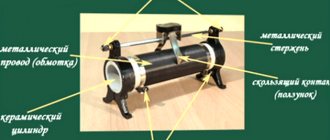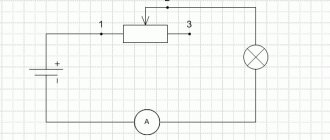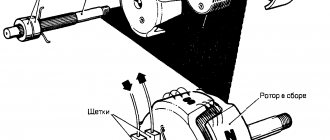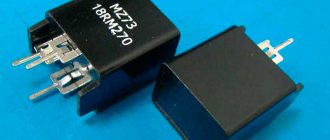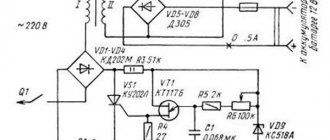Self-service and repair of VAZ cars is a common occurrence for many car owners. Periodic failure of some parts of the heating system is common in the “tenth” family. The most common problem is a broken heater rheostat. In the article we will look at where this element is located and how to replace it.
The heater rheostat (resistor) is responsible for changing the speed of the hot air flow through manual control inside the car. If this part fails, the heater fan operates only in the 4th extreme position. Constant operation of the electric motor at high speed leads to inconvenience in using the stove and rapid wear of the fan.
Purpose of rheostats
According to their purpose, rheostats are divided into the following types:
- starting ones, used to reduce the starting current when starting the electric motor;
- ballasts, used primarily in DC motors, as well as with alternating voltage in the case of an asynchronous electric motor with a wound rotor;
- load, creating resistance in the electrical circuit;
- ballast, necessary to absorb excess energy that occurs, for example, when braking an electric motor.
Rheostats are also used to limit the current in the excitation winding of DC electrical machines. Thanks to this, it is possible to achieve a reduction in electrical current surges and dynamic overloads that can damage both the drive itself and the mechanism connected to it. The use of resistance at start-up extends the life of the brushes and commutator.
Appearance of a slider rheostat with a protective casing
A special type of rheostat is a potentiometer. This is a voltage divider based on a variable resistor. Thanks to it, electronic circuits can use different voltages without using additional transformers or power supplies. Adjusting the current strength using a rheostat is widely used in radio engineering, for example, to change the volume of a speaker.
Self-diagnosis of stove malfunction
Read also: Why doesn’t puff pastry bake?
If the safety elements are intact, you need to check how efficient the fan is by first opening its power supply connector. The electric motor in the stove is located either in the space under the hood (behind the engine shield near the passenger compartment), or under the dashboard of the car interior.
The location of the heating fan and how to open it are in the vehicle operating instructions. There is also a circuit for starting the fan.
When studying the circuit, you need to find out which of the connector pins of the electric motor is positive when starting the first speed of the fan. Next, any contact of the control device is connected to this pin, another of its contacts is shorted to ground, the ignition system is turned on and the fan switch is turned to any position. If the control lamp turns on, then the cause of the fan malfunction is the electric motor. Otherwise, fan malfunctions occur due to a break in the wiring leading to the heating switch.
Operating principle
The operating principle of all rheostats is similar. The slider rheostat has the simplest design and visually clear principle of operation. It is connected to the circuit through the lower and upper terminals. The design is made in such a way that the current does not pass across the turns, but through the entire length of the wire selected by the slider. This occurs due to reliable insulation between the conductors.
Slider positions
In most slider positions, only part of the rheostat is activated. In this case, changing the length of the conductor leads to regulation of the current strength in the circuit. To reduce wear on the turns, the slider has a sliding contact, often made of a graphite rod or wheel.
Slider rheostat device
The rheostat has the ability to operate in potentiometer mode. To do this, when making a connection, you must use all three terminals. The bottom two are used as an entrance. They are connected to a voltage source. The top and one of the bottom terminals are output. When you move the slider, the voltage between them is adjusted.
Rheostat used as a voltage divider
In addition to the potentiometer, a ballast mode of operation of the rheostat is also possible, when it is necessary to create an active load for energy consumption. In this case, it is necessary to take into account what scattering abilities the device has. Excessive heat can damage the device, so it is recommended to connect the rheostat to the network, having previously calculated the power dissipation and, if necessary, ensure sufficient cooling.
How to avoid 2 mistakes when charging a battery
It is necessary to follow basic rules in order to properly charge the battery in your car.
- It is prohibited to connect the battery directly to the mains. Chargers are intended for this purpose.
- Even if the device is made with high quality and from good materials, you will still need to periodically monitor the charging process to avoid troubles.
Following simple rules will ensure reliable operation of self-made equipment. It is much easier to monitor the unit than to spend money on components for repairs.
The simplest battery charger
Types of rheostats
A popular type of rheostat used in industry and electric vehicles, for example, trams, is a device made in the form of a torus. Regulation occurs when the slider rotates around its axis. At the same time, it slides along windings located toroidally.
Toroidal view
A rheostat in the form of a torus changes resistance practically without creating a break in the circuit. In complete contrast to it is the lever view. The resistors are located on a special frame and are selected using a lever. Any switching is accompanied by a circuit break. In addition, in circuits with a lever rheostat there is no possibility of smoothly adjusting the resistance. All switchings lead to stepwise changes in network parameters. The discreteness of steps depends on the number of resistors on the frame and the control range.
Lever view
Like lever rheostats, plug-in rheostats regulate resistance in steps. A distinctive feature is changing network parameters without breaking the circuit. When the plug is in the jumper, most of the current flows beyond the resistance. The number of possible inclusion options depends on the size of the store. Pulling out the plug redirects the current to the resistor.
Plug rheostat
Specific types include lamp devices and liquid rheostats. Due to a number of shortcomings, these devices are not widely used. Liquid rheostats can only be found in explosive environments, where they perform engine control functions. Tube ones can be found in laboratories and in physics lessons, since their reliability and accuracy are not sufficient for widespread use.
Location of the heater resistor on VAZ 2110-2112
To replace a burnt-out resistor yourself, it is enough to know where the part is located, as well as to have a minimum set of tools on hand. Regardless of what year the car is, the location of the rheostat remains the same - in the engine compartment, near the heater fan. During a visual inspection, this resistance block cannot be seen, because it is hidden by a plastic cover (“frill”).
For an accurate understanding of where the part is located, here is a photo.
Design features
Rheostats are divided according to the material of manufacture:
- metal, which are most widespread;
- ceramic, most often used at low power;
- coal, still used in industry;
- liquid, providing the smoothest possible control.
Heat removal can be either air, water or oil. Liquid cooling is used when it is impossible to dissipate heat from the surface of the resistor. To increase heat transfer, a radiator with a fan can be used.
Manufacturing materials
What is insulation resistance measurement and why is it important
Rheostats are divided into 4 types based on the type of material they are made of. These are carbon, metal, liquid and ceramic RS:
- Carbon devices include models where a graphite rod acts as a variable resistance.
- A metal example of execution can be slider rheostats. They have a variable resistor - a coil of metal wire.
- Liquid variable resistances are used to control the operation of electric motors in explosive atmospheres.
- Ceramic rheostats include toroidal devices. Their device is described above in the text.
Sensors based on rheostats
There are direct relationships between the position of the rheostat slider, its resistance, the current in the circuit and the voltage. These features form the basis of the rotation angle sensor. Each position of the rotor in such a device corresponds to a certain electrical quantity.
Gradually, such sensors are being replaced by magnetic and optical devices. This is due to the fact that the characteristic of the dependence of angle and resistance is immune to interference from the influence of temperature. The transition to digital systems also contributes to the displacement of rheostatic sensors. Resistive meters can only be found in circuits that use analog signals.
Scheme of a 100% working 12 volt charger
Look in the picture at the diagram of a 12 V charger. The equipment is intended for charging car batteries with a voltage of 14.5 Volts. The maximum current received during charging is 6 A. But the device is also suitable for other batteries - lithium-ion, since the voltage and output current can be adjusted. All the main components for assembling the device can be found on the Aliexpress website.
- dc-dc buck converter.
- Ammeter.
- Diode bridge KVRS 5010.
- Hubs 2200 uF at 50 volts.
- transformer TS 180-2.
- Circuit breakers.
- Plug for connecting to the network.
- "Crocodiles" for connecting terminals.
- Radiator for diode bridge.
Replacement steps
This task is not difficult, but painstaking and difficult for absolute beginners. To avoid any difficulties, you must strictly follow the work plan described below.
- Disconnecting the “−” terminal of the battery and the wire.
- Dismantling the frill.
- Disconnecting the block with wires from the connector on the additional rheostat.
- Removing the fasteners on the resistor using a Phillips screwdriver of the appropriate size.
- Removing a faulty mechanism on the heater.
- Installing a working mechanism according to the same scheme, but in reverse order.
Dismantling the frill
This process is listed as one of the stages of work to replace the stove on Priora. It will not be possible to bypass it, especially since the frill will have to be removed when solving many problems with the heater. Even a basic filter replacement will require dismantling the windshield trim, also called a frill. To implement this task, you will need a thirteenth head, a screwdriver with a flat and Phillips head, and a marker. Further work will proceed according to the following scenario:
- We remove the windshield wiper blades.
- Using a marker, we make marks on the windshield that will indicate the location of the blades.
- We take out the decorative caps, which you just need to pry off with a screwdriver.
- Using a socket, unscrew the fastening nuts from the brush lever.
- It is convenient to remove the washers using tweezers.
- We remove the lever and brush from the shaft.
- We open the hood to carry out dismantling work regarding the seal, which is located on the edge of the front panel upholstery.
- We unscrew the fastening on the facings, dashboard upholstery, wind window trim.
The main reasons for the failure of the stove fan
There are many more reasons for failure, they arise for a variety of reasons, we will look at the most basic causes of failure, which even an ordinary car enthusiast who is not involved in professional repairs can eliminate.
The stove brushes are worn out or damaged
In such a situation, you need to disassemble the stove motor and be sure to replace the brushes. To do this, the impeller wheel is removed from the electric motor housing (it is usually secured with latches). If the catalog of automobile spare parts does not contain the necessary brushes, then you can unsolder the old analogues and replace them with identical ones in size. As a last resort, graphite-copper brushes are filed using a needle file.
Lighting
Recently, resistors have begun to be used in conjunction with LED lamps. This type of lamps has increasingly begun to be used on cars.
But not all cars yet come from the factory equipped with LED lighting devices, but it is quite possible to buy them separately and install them instead of standard incandescent lamps for the same turn signals or brake lights, and many do so.
But here a problem arises that requires the use of resistors.
The fact is that the electricity consumption of these lamps is very small, which is why the electronic unit regards the operation of the LEDs as a malfunction of the standard lamp.
To correct the situation, resistors are used to create a load on the wiring lines that power those lighting fixtures in which LED lamps are installed.
As a result, the ECU perceives the resistance of the element as the work of an incandescent lamp, so no error code occurs.
It is interesting that when using such decoys, the main advantage of LED lamps - low energy consumption - is reduced to zero, and they have only one advantage over conventional incandescent lamps - a long service life.
How to check the cabin air temperature sensor?
In this case, if you set the controller knobs of the automatic heater control system to the “MIN” and “MAX” positions at the corresponding points (blue and red), then the fan should not rotate.
If the mechanism is not working efficiently, the first thing to do is check the amount of coolant. Look at the expansion tank: there are warning marks on it, and on the system block there is an indicator.
However, it is more common to see broken tabs on the heater unit housing. In this case, experts recommend replacing the stove motor or its bushing. Sometimes the fan makes noise because of the washers, which are used to eliminate axial play. The element needs to be removed and cleaned.
The unit receives information about the temperature in the cabin from a sensor located on the ceiling and equipped with a microfan. If necessary, the unit can operate a micromotor that controls the heater dampers.
Damage to the ceiling temperature sensor. Therefore, you need to check whether the radiator is hot. Difficulties with heating may arise due to a lack of fluid in the car’s engine cooling system. When the temperature in the cabin cannot be controlled, the reasons may be abnormalities in the operation of the control unit or a malfunction of the damper. The damper is accessible through the engine compartment.
MMR (micromotor reducer) (9), information about the position of the heater damper. If, with the doors and windows closed, after 15 minutes the temperature in the cabin does not correspond to the set temperature, then the heater control unit should be adjusted. To do this, you should connect a known working heater control unit (borrow from a friend or from a store). Set the regulators to position 0 and remove, and then remove the front cover and glass from the latches. Often, due to high temperatures, the board becomes very hot and the contact is soldered off. If there are no visible defects, then you need to look for the cause by disassembling it (indicated in the photo). Another reason could be poor contact in the fuse box.
I have a problem, apparently a trivial one, but I can’t solve it. On 2111, 2004 (as I understand it, the stove is a new model. The panel near the passenger’s left knee and inside the glove compartment is heating up suspiciously. SAUO 1333.3854 does not react in any way to the position of the MMR. You turn on the ignition - the MMR spins in one direction for 13 seconds, regardless of the position of the temperature regulator I measured the resistance of the MMR, when rotating it smoothly changes from 0 to 5 kOhm (and back from 5 kOhm to 0 when turning the temperature regulator to cold) - that is, the position sensor in the MMR is working.
When winter comes, the issue of heating system efficiency is more pressing. Let's look at the typical faults that VAZ-2110 owners most often encounter.
I started the car in the evening and smelled something burning. The heater was turned on at first speed and when I started it, apparently all the energy was spent to start the engine, but the heater motor did not start. As a result, the heater heater resistor burned out. I turned on the 4th one, it works. And the stove fan works at 4 even without a resistor. Just don’t know why a turbo aircraft is needed at all)
